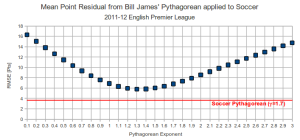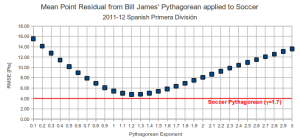Why the baseball Pythagorean doesn’t work for soccer
Categories: Soccer Pythagorean: Theory
I see that a lot of people have been visiting this site because of Devin Pleuler’s article on the soccer Pythagorean expectation that we’ve developed. Welcome to Soccermetrics! We’re all about creating knowledge and insight from the data revolution that has overtaken soccer in the last few years. If you’re intrigued and want to dip more than a couple of toes in the water, please read on.
Before the soccer Pythagorean was derived, a lot of people have attempted to apply the baseball Pythagorean directly to soccer. I haven’t written on its shortcomings in much detail, but in this post I’m going to go into the reasons why the original formula doesn’t work for football.
Here is Bill James’ original Pythagorean formula:
This equation (or to be really technical, a model) relates win percentage in baseball to runs scored and runs allowed. Now, Bill James originally used 2.0 as the exponent term that best fit the expected win percentages of all the teams in a league to their real values. Selecting 2.0 as the exponent is convenient because it the formula looks like the famous Pythagorean formula and permits some visual insight (I’ll leave that as an exercise for the motivated reader). Later sabermetrician showed that the best exponent to use is approximately 1.8, which speaks very well of James’ intuition.
Say you want to apply this formula to soccer. Replace “runs” with “goals” and win percentage with points percentage (points earned / possible points), and then set the Pythagorean exponent to the Greek letter γ:
Multiply points percentage by total possible points (number of league matches by three points) and you get expected points. It’s no surprise that so many have attempted to use James’ formula first. It’s simple and intuitive to use and understand. But when applied to football the baseball Pythagorean falls short in two ways:
- The baseball Pythagorean consistently underestimates point totals.
- The root-mean-square error of the estimation is very high.
To illustrate let’s apply the James’ Pythagorean to last season’s English Premier League.
To obtain the Pythagorean exponent that best fits the expectation to reality, we take the difference between each team’s actual point total and their expected total, square that amount, repeat the process for all of the teams in the league and then add the values together. This is the league mean-square error of the Pythagorean and if you take the square root you get the league root-mean-square error or RMSE. We want to find the Pythagorean exponent that minimizes the league RMSE.
We can find this exponent graphically by calculating the league RMSE over a range of values and plotting them. (There are more sophisticated ways to find the exponent, but the math is much more involved.) Such a plot looks like this:
The league RMSE bottoms out (reaches a minimum, to be precise) at around γ = 1.3, which we will call the league Pythagorean exponent. As a quick aside, how does the league exponent change for different leagues? Let’s look at last season’s Spanish La Liga:
Here the league RMSE reaches a minimum at γ = 1.2. In fact, the league Pythagorean exponents for Bill James’ formula is between 1.1 and 1.4, admittedly over a small samples of leagues (I looked at last season’s Big Five European leagues and the just-concluded MLS regular season).
But take a look at both figures again. The red line is the RMSE for the soccer Pythagorean that I derived, using the Pythagorean exponent that best fit expected points to reality over a large number of leagues. (It’s our ‘universal’ Pythagorean exponent of 1.70.) In both plots, the best-case RMSE from James’ Pythagorean formula applied to soccer is still larger than the RMSE of the soccer Pythagorean. Over the leagues that I’ve plotted this finding persists. Again, it’s a small sample space and I’ll leave an exhaustive study to someone else (I’ll happily link to the post that presents one), but I’m confident that even in the best case, the Jamesian Pythagorean has a consistently higher RMSE than my soccer Pythagorean.
So what do the estimated point totals look like? Once again, let’s look at the English Premier League. The table below presents goals scored/allowed by Premiership teams, with actual point totals, Pythagorean expectations (James’ and mine), and the resulting residuals. The James Pythagorean uses an exponent of 1.3, and the soccer Pythagorean uses an exponent of 1.7.
| Team | GF | GA | Pts | Pythag (BJ) | Pythag (HH) | Pts – PyBJ | Pts – PyHH |
| Manchester City | 93 | 29 | 89 | 93 | 88 | -4 | 1 |
| Manchester United | 89 | 33 | 89 | 89 | 82 | -0 | 7 |
| Arsenal | 74 | 49 | 70 | 72 | 68 | -2 | 2 |
| Tottenham Hotspur | 66 | 41 | 69 | 74 | 69 | -5 | 0 |
| Newcastle United | 56 | 51 | 65 | 60 | 55 | 5 | 10 |
| Chelsea | 65 | 46 | 64 | 70 | 63 | -6 | 1 |
| Everton | 50 | 40 | 56 | 65 | 59 | -9 | -3 |
| Liverpool | 47 | 40 | 52 | 63 | 56 | -11 | -4 |
| Fulham | 48 | 51 | 52 | 55 | 49 | -3 | 3 |
| West Bromwich Albion | 45 | 52 | 47 | 52 | 46 | -5 | 1 |
| Swansea City | 44 | 51 | 47 | 52 | 46 | -5 | 1 |
| Norwich City | 52 | 66 | 47 | 48 | 45 | -1 | 2 |
| Sunderland | 45 | 46 | 45 | 56 | 50 | -11 | -5 |
| Stoke City | 36 | 53 | 45 | 43 | 41 | 2 | 4 |
| Wigan Athletic | 42 | 62 | 43 | 43 | 40 | 0 | 3 |
| Aston Villa | 37 | 53 | 38 | 44 | 41 | -6 | -3 |
| Queens Park Rangers | 43 | 66 | 37 | 42 | 39 | -5 | -2 |
| Bolton Wanderers | 46 | 77 | 36 | 39 | 35 | -3 | 1 |
| Blackburn Rovers | 48 | 78 | 31 | 40 | 35 | -9 | -4 |
| Wolverhampton Wanderers | 40 | 82 | 25 | 32 | 29 | -7 | -4 |
| RMSE | 5.808 | 3.814 |
The main feature of the Jamesian Pythagorean when applied to soccer is that it consistently overestimates point totals. There are some teams that persistently overperform in the Jamesian Pythagorean and the soccer Pythagorean, such as Newcastle, Stoke, and Wigan, and some teams identified as underperformers in the soccer Pythagorean have highly negative residuals in James’ Pythagorean. Manchester United’s performance — perceived as significantly overperforming according to the soccer Pythagorean — is in line with statistical expectations according to James’ expectation.
It’s possible to argue that both expectations do quite well at identifying the significant outliers in a league competition. My perspective is that the inability to estimate the probability of draws in the Jamesian Pythagorean yields an estimator that has a persistently high RMSE and high level of bias. Neither characteristic is found in the Jamesian Pythagorean when applied to baseball, and I would hypothesize that it’s not present when applied to basketball, American football, or any other sport with no draws (or very few).
So to conclude, Bill James’ Pythagorean expectation provides a lot of insight in baseball and has been adapted to other sports, but it fails in soccer. We’ve addressed the underlying assumptions of the original formula and developed a new metric that adapts those assumptions to football competitions. We like the results and we’re developing more metrics like it to enlighten our understanding of this great game.



